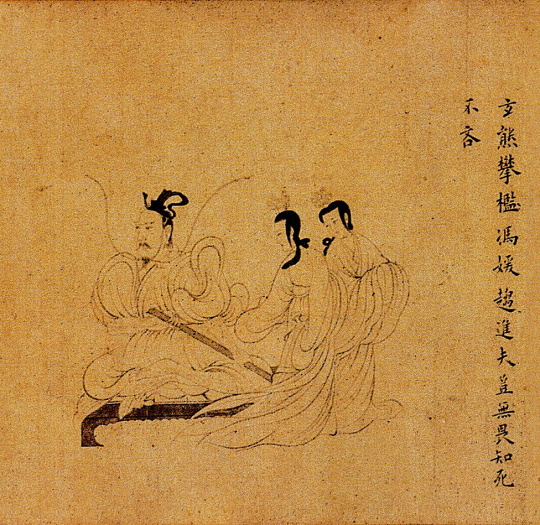#chineseswordfencing
Explore tagged Tumblr posts
Text
Twilight Jianfa!
After training 3 days at Rodell Laoshi’s St. Paul Seminars, they wanted to test their sword skills. So out they went to the local plaza for some friendly bouting.
Seen on the left is Richard Son Su Meyer, director of Great River Taoist Center Twin Cities. And on the right is Quinatzin De La Torre. Both are long time students of Rodell Laoshi.
Note that both have years of experience in full contact swordplay and are able to control the power of their blows, even at full speed. Less experienced practitioners must don proper swordplay armor, particularly head and eye protection, when bouting.
#jianfa#chineseswordsmanship#jianshu#chineseswordfighting#chineseswordplay#chinesemartialarts#scottmrodell#duanbing#chinesemartialart#swordplay#taijijian#taichisword#yangjiamichuantaijijian#taijiswordfencing#chineseswordfencing#kungfuweapons#swordfightingclasses#swordfightingskills#swordfightingschool#daoistswordarts#daoistswordart#chinesesword#swordarts#swordfight#swordfighter#wudangsword#chineseswordwork#wudangjian#fullcontact#ukchineseswordfighting
13 notes
·
View notes
Text



The history of the Chinese Fast Sword Draw (出劍法) dates back to the Han dynasty, 2,000 plus years ago. Unfortunately, there are no known manuals for these techniques and historically illustrations are rare. This depiction of a seated swordsman drawing his sword is from a scroll originally painted by Gu Kaizhi ( 顧愷之) in the 4th century. While Gu’s original version of this scroll, The Admonitions of the Instructress to the Court Ladies (女史箴圖) has not survived, later copies of this work have.
The two following later copies of this scroll date to the Tang (dated between the 6th and 8th century AD) and Song dynasties. As such they are likely the oldest known illustrations of a Chinese Swordsman Preforming the Fast Sword Draw (出劍法). They are also the only know depiction of a seated Chinese sword drawn know to date. Given the age of the two paintings, it is difficult to make out the finer details. What we can see is that seated swordsman’s grip is palm out with his fingers wrapping over the grip prepared to draw and strike downward. His rear hand is well back toward the rear of the scabbard, palm down.
A skeptic might understandable suggest that the seated figure is actually wielding a cudgel. Given the lack of visible detail, this would be an understandable suggestion. However, there is no reason for a wooden club to be gripped at the rear end just prior to swinging it. And given that what appears to be bear is just before the seated man, if it were some sort of cudgel and not a sword ready to be drawn, it is more likely he would be gripping it with two hands not holding the the rear end palm down.
Note: the Tang period example of The Admonitions of the Instructress to the Court Ladies is in the collection of the British Museum in London. The Song period (960-1279) example is the property of the Palace Museum in Beijing.
#出劍法#chineseswordsmanship#jianfa#chineseswordfighting#chineseswordplay#scottmrodell#chinesemartialarts#duanbing#chineseswordsman#chineseswordarts#daoistswordarts#swordfighting#chineseswordfencing#taijiswordfencing#swordfightingskills#kungfuweapons#iaido#scottrodell#testcutting#jianshu#chineseswordart#swordarts#swordsmanship#historicalswordsmanship#swordplay#chinesesword#chineseswords#daofa
8 notes
·
View notes
Text

SIGNUP TO OUR MONTHLY NEWSLETTER
DOWNLOAD OUR NEW EBOOK HERE https://www.chineseswordacademy.com/ebooksignup
The Basic Cuts of Yang Taiji Jianfa by Scott M. Rodell
Descriptions of all the basic cuts of Yang Taiji Jianfa including their usage in free swordplay.
#chineseswordsmanship#jianfa#chineseswordfighting#chineseswordplay#scottmrodell#chinesemartialarts#duanbing#chinesemartialart#scottrodell#yangjiamichuantaijijian#taijiswordfencing#taijisword#taijijian#taichisword#yangstyle#yangstylestaijiquan#yangfamilytaijiquan#yangstyletaichichuan#chinesesword#chineseswordfencing#kungfuweapons#swordfighter#chineseswordwork#swordfightingskills#swordfightingschool#swordfightingclasses#swordclasses#swordclass#jianshu#daoistswordarts
2 notes
·
View notes
Text
During the Qing period, the dao (Chinese Saber) was most commonly slung from the waist with the hilt facing back. When work with a bow holster, this placed the hilt out of way and within easy reach. Drawing the dao from this position is easy enough when standing, but seem problematic when seated. As seen here, where a Daoke is getting a pedicure. If he rotated the hilt forward to draw in what is believed was the standard method, he would very likely be impeded by the bench he is seated on.

Perhaps this potential obstacle to the sword draw was negated by quickly standing. Whatever was the case, there is still clearly a great deal about the details for Chinese Sword Drawing that remains unknown.
#chineseswordsmanship#chineseswordfighting#chineseswordplay#scottmrodell#swordplay#duanbing#chinesemartialarts#chinesemartialart#sworddrawing#sworddrawingtechnique#daofa#chineseswordwork#chineseswordarts#chineseswordart#swordarts#kungfuweapons#swordfightingschool#swordfightingskills#chineseswords#chineseswordfencing#kungfu#gongfu#qingdynasty#swordfighter#swordfighting
4 notes
·
View notes
Text
Quick Draw with the Rodell Cutting Jian -
Some 5 plus years ago, I began working on reconstructing Chinese Fast Drawing Techniques. Here’s my early effort.
Thoughts on Sword Tricks...
During my winter break from seminars, I thought I would have some fun and try my hand at a few sword tricks from different traditions. In all honesty, some of the tricks preformed are essentially just that, tricks. What I mean by that is that they do not embody any skill a swordsman might actually use in a duel. And so, they don’t provide the swordsman with any useful training. They are just for entertainment.
When I started practicing throwing an apple in the air, cutting it, I was thinking it was just a trick and it might even be fairly criticized as showing off. (I bought a bag of small wiffle balls to practice with in the wuguan. I didn’t want to waste food). And there is certainly a trick to this trick. You have to throw the ball or apple where you can cut it. You have to practice throwing the same height each time too, so that he pacing is always about the same. You have to practice the timing of the throw and draw. It is easy to watch the ball or apple too long and draw late. So as I practiced, usually in the short time after dinner and before students arrived for the evening classes, I observed other useful aspects of this practice. For example, the delay I mentioned. You cannot separate watching the target and cutting. When you do, the body and mind and essentially separate for a moment. When you start to cut, there is a delay, and you tend to miss.
As when shooting arrows, if you start thinking about how you are doing well after hitting several in a row, your mind is elsewhere and you are probably going to miss the next one. There is also a tendency to over swing after the cut. This is a common error in most students’ cutting. The control of the after cut is the most difficult aspect of good cutting technique. If you let yourself start chasing the ball, you tend to swing like you are trying to hit it out of the park.
In a way, practicing cuts That one normally would not is like any different sort of training that takes one out of comfortable territory. Any sort of new cutting provides a fresh look at one’s skills. A fresh opportunity to critique one’s practice. So in hindsight, I am finding sword tricks I did for amusement to be an unexpected and useful test of my skills. Not in the sense that these are difficult or physically demanding cuts, but in the sense that they gave me a clean look at my practice. In a way, what does it matter if a cut is just a “trick?” Perhaps what is more important is how one makes use of practice time?
Then again, no big deal, baseball players hit balls all the time.
#jianfa#chineseswordsmanship#chinesemartialarts#duanbing#scottmrodell#daoistswordsman#chinesesword#chineseswordarts#taijijian#taijiswordfencing#taijisword#chineseswordfencing#chineseswordplay#testcutting#tameshigiri#swordclass#swordfightingskills#swordfightingart#swordfightingschool#wudangjian#kungfuweapons#chinesemartialart#chineseswordfighting#jianshu#yangjiamichuantaijijian#yangstylestaijiquan#yangfamilytaijiquan
1 note
·
View note
Text

WANT TO LEARN CHINESE SWORDSMANSHIP? INSTANT ACCESS. ANYWHERE. ANYTIME. Sign up for our FREE 7 DAY TRIAL.
Find a study path that’s right for you.
#jianfa#chineseswordsmanship#chineseswordfighting#scottmrodell#chineseswordplay#chinesemartialarts#duanbing#jianshu#chineseswordarts#daoistswordart#taijiswordfencing#taijisword#taijijian#wudangsword#wudangjian#swordclasses#swordfightingschool#swordfightingskills#kungfuweapons#chineseswordfencing#historicalfencing#swordarts#swordfighting#swordfightingclasses#fullcontact#swordplay#yangjiamichuantaijijian#yangstyletaichi#yangstylestaijiquan#yangstyle
0 notes